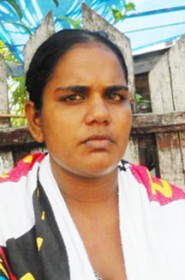With pain attacking her body in steady waves the thought foremost on her mind was the well-being of her unborn child. As she struggled to deliver a 4.4 kilo baby she kept telling medical personnel around her that she needed a caesarean (C-section) but they laughed; laughter was the last thing Seelochanie Ramlochan wanted or expected to hear from them.
Ramlochan, 37, delivered a still-born baby on September 23. Negligence by staff at the Georgetown Public Hospital Corporation (GPHC), she insists, resulted in her child’s death. This is the latest in a string allegations levelled against the hospital’s maternity department.

“They tell me to shut up,” Ramlochan recalled, “and then they start to laugh and tell me that only last week a woman with fibroids deliver a baby just like this and didn’t have to get no C-section.”
The day before (September 22) Ramlochan said she signed paper work for a C-section to be done. During her fifth month of pregnancy, she explained, the Plaisance Health Centre had referred her to the clinic at GPHC. She was suffering from fibroids and was experiencing pain to the abdomen when Plaisance made the referral. It was at that health centre, Ramlochan said, that she was first told that she could not deliver her baby vaginally and would need a C-section.
On September 22, the woman said, she started complaining about pain. She was later seen by a doctor (not the one who admitted her and was supposed to be monitoring her condition). This doctor, according to her, recommended her for a C-section and told her than an ultrasound would have to be done the next day. Later, the same doctor questioned his colleague about why she (Ramlochan) had not been recommended for an ultrasound up to that point.
Ramlochan was already 12 days past the estimated date of her delivery. The ultrasound was never done. At about 2.30 am on September 23 the woman said she started having labour pains. She was subsequently taken to the delivery room.
A third doctor, Ramlochan said, delivered her baby despite protests from her that she should be getting a C-section.
“I told him. I told [name of doctor] that I had fibroids and I was recommended for a C-section but he still make me push and up to now I can’t even tell you how they get out my baby from down there but I know he use some scissors kind of thing,” Ramlochan explained.
On the chart in her clinic booklet it is clearly stated that at 3.50am on September 23 Ramlochan “delivered normally aided by episiotomy (an incision through the perineum made to enlarge the vagina and aid in childbirth) a still baby girl”. Further down on the same chart stated: “Patient’s post-partum condition seems fair”. Never at any time, Ramlochan said, did the doctor involved in her delivery sign any hospital form or paper.

When they took the relevant paperwork to police while arranging their daughter’s funeral, Waheed Rohoman said, they were questioned about why the doctor’s signature was not there.
The back of their daughter’s head, Rohoman said, was somehow wounded during the delivery.
This was his wife’s second child, the man explained. They have a son who is 21. After their daughter died they were too weakened and had no hope of getting any kind of satisfaction from any authority.
“Complaining about anything in this country take so much time and energy and then you get no satisfaction at all,” the man said.
He further added that when they approached relevant medical personnel at the hospital about what had caused their daughter’s death they were told that the umbilical cord was wrapped around the child and that she’d been consuming her own waste. A post-mortem examination was never conducted.
Delivered in theatre
The same story about the umbilical cord being wrapped around the child’s neck causing them to consume their waste is one of the many stories, a young Better Hope mother said is being told to her and her relatives by staff at GPHC.
Savita Paltoo, 23, was also referred to the GPHC by the Plaisance Health Centre. The woman said she joined the Plaisance clinic during the third month of her pregnancy and nearing the end after she started complaining for pain she was advised that she could not deliver the baby vaginally.
The woman said she, like Ramlochan, was recommended for a C-section but after she complained about pains she was initially taken to the delivery room.
On November 1, Paltoo related, she went to the Plaisance clinic. It was her due date and the doctor explained to her that the baby “was not full turned” and she was referred to the GPHC. The following day Paltoo said she presented herself to the public hospital and was admitted.
Two days later, November 4, Paltoo said an ultrasound was done but she was told nothing about what it did or did not show. On November 6 the woman said she started to get pains and was passing blood. When she told this to a nurse on duty at the time, Paltoo alleged, she was told: “You must get a little pain”. The same morning a second doctor (not the one who admitted her) broke her water bag. This was done before 12pm.
After 12pm that day Paltoo said she went to the nurse again about the pains and this time she was given intravenous drips. Between 1.30 and 2pm that day she was taken to the labour room.
Paltoo alleged that when the nurse called the doctor the doctor refused to come tend to her in the labour room. The doctor, Paltoo said, told her that she was “not getting enough pain to push the child”.
An argument, according to Paltoo, then erupted between the nurse and doctor. The nurse, the woman said, eventually told the doctor that if the doctors didn’t want to tend to the patient then they would do it.
Hours later, at about 5 to 5.30 pm, Paltoo said she was signed up for a C-section. This was done long after she had been insisting that she would have to have a C-section. Preparations were then made to take her to the theatre.
However, by the time she made it over to the theatre the baby’s head was already out Paltoo said and it was the doctor there who dealt with her delivery. Despite her recommendation for a C-section Paltoo was forced to vaginally deliver her baby.
“As soon as it over I know that something wasn’t right because baby didn’t cry…the first time I saw the baby they had a oxygen mask over his face and when I ask them what was wrong the doctor from in the theatre told me that they took too long to get the baby out of me,” Paltoo said.
Her child, the woman recalled, was then placed in an incubator and later moved to the Intensive Care Unit (ICU). Every time she asked the doctor about her child’s welfare the woman said that all she was being told was that the baby was “critical”.
“After my child get move to the ICU he never open his eyes again and he never move again,” Paltoo said.
Paltoo and her relatives said they have been given various explanations from different doctors and nurses, all of whom were involved in the woman’s care at some point, about why the child died. A post-mortem examination will be conducted this morning. However, the distressed mother and her relatives continue to insist that they believe it was negligence of GPHC staff which contributed to the child’s demise.
The deaths of Aseelah Haqq, Esther Dwarka-Bowlin, and nurse Charlene Amsterdam during childbirth have also been blamed on the negligence of the public health care system.




